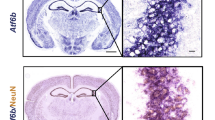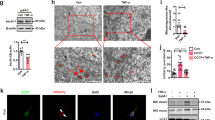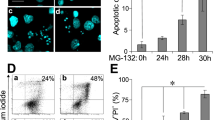Abstract
We investigated the cytoprotective effects of lithium, the mood-stabilizer, on thapsigargin-induced stress on the endoplasmic reticulum (ER) in rat PC12 cells. Protracted lithium pretreatment of PC12 cells elicited cytoprotection against thapsigargin-induced cytotoxicity. Lithium protection was concurrent with inhibition of thapsigargin-induced intracellular calcium increase and with elevated expression of the molecular chaperone GRP78. Moreover, lithium pretreatment upregulated the antiapoptotic protein Bcl-2, and blocked Bcl-2 downregulation elicited by thapsigargin. Prior to the induction of GRP78, lithium treatment alone increased the expression of c-Fos whose induction by ER stress is necessary for GRP78 induction. Curcumin, an inhibitor of transcription factor AP-1, blocked lithium cytoprotection against thapsigargin cytotoxicity. Thus, the induction of GRP78 and Bcl-2, and activation of AP-1 likely contribute to lithium-induced protection against cytotoxicity resulting from ER stress. Additionally, thapsigargin-induced cytotoxicity was suppressed by pretreatment with another mood-stabilizer, valproate, indicating that cytoprotection against ER stress is a common action of mood-stabilizing drugs.
This is a preview of subscription content, access via your institution
Access options
Subscribe to this journal
Receive 6 print issues and online access
$259.00 per year
only $43.17 per issue
Buy this article
- Purchase on Springer Link
- Instant access to full article PDF
Prices may be subject to local taxes which are calculated during checkout







Similar content being viewed by others
Abbreviations
- AP-1:
-
activator protein-1
- ER:
-
endoplasmic reticulum
- GRP78:
-
78 kDa glucose-regulated protein
- GSK-3β:
-
glycogen synthase kinase-3β
- LDH:
-
lactate dehydrogenase
- NMDA:
-
N-methyl-D-aspartate
- PC12:
-
rat pheochromocytoma cells
- VPA:
-
valproate
References
Rao RV, Ellerby HM, Bredesen DE . Coupling endoplasmic reticulum stress to the cell death program. Cell Death Different 2004; 11: 372–380.
Ma Y, Hendershot LM . The mammalian endoplasmic reticulum as a sensor for cellular stress. Cell Stress Chaperones 2002; 7: 222–229.
Rutkowski DT, Kaufman RJ . A trip to the ER: coping with stress. Trends Cell Biol 2004; 14: 20–28.
Nakagawa T, Zhu H, Morishima N, Li E, Xu J, Yankner BA et al. Caspase-12 mediates endoplasmic-reticulum-specific apoptosis and cytotoxicity by amyloid-beta. Nature 2000; 403: 98–103.
Liu H, Bowes RC, vandeWater B, Sillence C, Nagelkerke JF, Stevens JL . Endoplasmic reticulum chaperones GRP78 and calreticulin prevent oxidative stress, Ca2+ disturbances, and cell death in renal epithelial cells. J Biol Chem 1997; 272: 21751–21759.
Wei MC, Zong WX, Cheng EHY, Lindsten T, Panoutsakopoulou V, Ross AJ et al. Proapoptotic BAX and BAK: a requisite gateway to mitochondrial dysfunction and death. Science 2001; 292: 727–730.
Germain M, Mathai JP, Shore GC . BH-3-only BIK functions at the endoplasmic reticulum to stimulate cytochrome c release from mitochondria. J Biol Chem 2002; 277: 18053–18060.
Mattson MP, LaFerla FM, Chan SL, Leissring MA, Shepel PN, Geiger JD . Calcium signaling in the ER: its role in neuronal plasticity and neurodegenerative disorders. Trends Neurosci 2000; 23: 222–229.
Sherman MY, Goldberg AL . Cellular defenses against unfolded proteins: a cell biologist thinks about neurodegenerative diseases. Neuron 2001; 29: 15–32.
Paschen W . Endoplasmic reticulum: a primary target in various acute disorders and degenerative diseases of the brain. Cell Calcium 2003; 34: 365–383.
Nonaka S, Hough C, Chuang D-M . Chronic lithium treatment robustly protects CNS neurons against excitotoxicity by inhibiting NMDA receptor-mediated calcium influx. Proc Natl Acad Sci USA 1998; 95: 2642–2647.
Hashimoto R, Hough C, Nakazawa T, Yamamoto T, Chuang D-M . Lithium protection against glutamate excitotoxicity in rat cerebral cortical neurons: involvement of NMDA receptor inhibition possibly by decreasing NR2B tyrosine phosphorylation. J Neurochem 2002; 80: 589–597.
Wei H, Leeds PR, Qian Y, Wei W, Chen R-W, Chuang D-M . β-Amyloid-induced death of PC 12 cells and cerebellar neurons is inhibited by long-term lithium treatment. Eur J Pharmacol 2000; 392: 117–123.
Bijur GN, De Sarno P, Jope RS . Glycogen synthase kinase-3beta facilitates staurosporine- and heat shock-induced apoptosis. Protection by lithium. J Biol Chem 2000; 275: 7583–7590.
Kanai H, Sawa A, Chen R-W, Leeds P, Chuang D-M . Valproic acid inhibits histone deacetylase activity and suppresses excitotoxicity-induced GAPDH nuclear accumulation and apoptotic death in neurons. Pharmacogenomics J 2004; 4: 336–344.
Nonaka S, Katsube N, Chuang D-M . Lithium protects rat cerebellar granule cells against apoptosis induced by anticonvulsants, phenytoin and carbamazepine. J Pharmacol Exp Ther 1998; 286: 539–547.
Li R, Shen Y, El-Mallakh RS . Lithium protects against ouabain-induced cell death. Lithium 1994; 5: 211–216.
Hennion JP, El-Masri MA, Huff MO, El-Mallakh RS . Evaluation of neuroprotection by lithium and valproic acid against ouabain-induced cell damage. Bipolar Disord 2002; 4: 201–206.
D'Mello SR, Anelli R, Calissano P . Lithium induces apoptosis in immature cerebellar granule cells but promotes survival of mature neurons. Exp Cell Res 1994; 211: 332–338.
Alvarez G, Munoz-Montano JR, Satrustegui J, Avila J, Bogonez E, Diaz-Nido J . Lithium protects cultured neurons against beta-amyloid-induced neurodegeneration. FEBS Lett 1999; 453: 260–264.
Tseng WP, Lin-Shiau SY . Long-term lithium treatment prevents neurotoxic effects of beta-bungarotoxin in primary cultured neurons. J Neurosci Res 2002; 69: 633–641.
Nonaka S, Chuang D-M . Neuroprotective effects of chronic lithium on focal cerebral ischemia in rats. Neuroreport 1998; 9: 2081–2084.
Ren M, Senatorov VV, Chen R-W, Chuang D-M . Post-insult treatment with lithium reduces brain damage and facilitates neurological recovery in a rat ischemia/reperfusion model. Proc Natl Acad Sci USA 2003; 100: 6210–6215.
Xu JH, Culman J, Blume A, Brecht S, Gohlke P . Chronic treatment with a low dose of lithium protects the brain against ischemic injury by reducing apoptotic death. Stroke 2003; 34: 1287–1292.
Wei H, Qin ZH, Senatorov VV, Wei W, Wang Y, Qian Y et al. Lithium suppresses excitotoxicity-induced striatal lesions in a rat model of Huntington's disease. Neuroscience 2001; 106: 603–612.
Senatorov VV, Ren M, Kanai H, Wei H, Chuang D-M . Short-term lithium treatment promotes neuronal survival and proliferation in rat striatum infused with quinolinic acid, an excitotoxic model of Huntington's disease. Mol Psychiatry 2004; 9: 371–385.
Pascual T, Gonzalez JL . A protective effect of lithium on rat behaviour altered by ibotenic acid lesions of the basal forebrain cholinergic system. Brain Res 1995; 695: 289–292.
Sparapani M, Virgili M, Ortali F, Contestabile A . Effects of chronic lithium treatment on ornithine decarboxylase induction and excitotoxic neuropathology in the rat. Brain Res 1997; 765: 164–168.
Hashimoto R, Takei N, Shimazu K, Christ L, Lu B, Chuang D-M . Lithium induces brain-derived neurotrophic factor and activates TrkB in rodent cortical neurons: an essential step for neuroprotection against glutamate excitotoxicity. Neuropharmacology 2002; 43: 1173–1179.
Chalecka-Franaszek E, Chuang D-M . Lithium activates the serine/threonine kinase Akt-1 and suppresses glutamate-induced inhibition of Akt-1 activity in neurons. Proc Natl Acad Sci USA 1999; 96: 8745–8750.
Kopnisky KL, Chalecka-Franaszek E, Gonzalez-Zulueta M, Chuang D-M . Chronic lithium treatment antogonizes glutamine-induced decrease of phosphorylated CREB in neurons by reducing PP1 and increasing MEK activities. Neurosci 2003; 116: 425–435.
Einat H, Yuan PX, Gould TD, Li JL, Du JH, Zhang L et al. The role of the extracellular signal-regulated kinase signaling pathway in mood modulation. J Neurosci 2003; 23: 7311–7316.
Klein PS, Melton DA . A molecular mechanism for the effect of lithium on development. Proc Natl Acad Sci USA 1996; 93: 8455–8459.
De Sarno P, Li X, Jope RS . Regulation of Akt and glycogen synthase kinase-3β phosphorylation by sodium valproate and lithium. Neuropharmacology 2002; 43: 1158–1164.
Zhang F, Phiel CJ, Spece L, Gurvich N, Klein PS . Inhibitory phosphorylation of glycogen synthase kinase-3 (GSK-3) in response to lithium: evidence for autoregulation of GSK-3. J Biol Chem 2003; 278: 33067–33077.
Hashimoto R, Fujimaki K, Jeong MR, Christ L, Chuang D-M . Lithium-induced inhibition of Src tyrosine kinase in rat cerebral cortical neurons: a role in neuroprotection against N-methyl-D-aspartate receptor-mediated excitotoxicity. FEBS Lett 2003; 538: 145–148.
Song L, De Sarno P, Jope RS . Central role of glycogen synthase kinase-3β in endoplasmic reticulum stress-induced caspase-3 activation. J Biol Chem 2002; 277: 44701–44708.
Thastrup O, Cullen PJ, Drobak BK, Hanley MR, Dawson AP . Thapsigargin, a tumor promoter, discharges intracellular Ca-2+ stores by specific-inhibition of the endoplasmic-reticulum Ca-2+-ATPase. Proc Natl Acad Sci USA 1990; 87: 2466–2470.
Katayama T, Imaizumi K, Sato N, Miyoshi K, Kudo T, Hitomi J et al. Presenilin-1 mutations downregulate the signalling pathway of the unfolded-protein response. Nat Cell Biol 1999; 1: 479–485.
Yu Z, Luo H, Fu W, Mattson MP . The endoplasmic reticulum stress-responsive protein GRP78 protects neurons against excitotoxicity and apoptosis: suppression of oxidative stress and stabilization of calcium homeostasis. Exp Neurol 1999; 155: 302–314.
Aoki T, Koike T, Nakano T, Shibahara K, Kondo S, Kikuchi H et al. Induction of Bip mRNA upon programmed cell death of differentiated PC12 cells as well as rat sympathetic neurons. J Biochem (Tokyo) 1997; 121: 122–127.
He H, McColl K, Distelhorst CW . Involvement of c-Fos in signaling grp78 induction following ER calcium release. Oncogene 2000; 19: 5936–5943.
Kalasapudi VD, Sheftel G, Divish MM, Papolos DF, Lachman HM . Lithium augments fos protoonocogene expression in PC12 phoechromocytoma cells: implications for therapeutic action of lithium. Brain Res 1990; 521: 47–54.
Gao X-M, Fukamauchi F, Chuang D-M . Long-term biphasic effects of lithium treatment on phospholipase C-coupled m3-muscarinic acetylcholine receptors in cultured cerebellar granule cells. Neurochem Int 1993; 22: 395–403.
Sikora E, Bielak-Zmijewska A, Piwocka K, Skierski J, Radziszewska E . Inhibition of proliferation and apoptosis of human and rat T lymphocytes by curcumin, a curry pigment. Biochem Pharmacol 1997; 54: 899–907.
Lam M, Dubyak G, Chen L, Nunez G, Miesfeld RL, Distelhorst CW . Evidence that Bcl-2 represses apoptosis by regulating endoplasmic reticulum-associated Ca2+ fluxes. Proc Natl Acad Sci USA 1994; 91: 6569–6573.
He H, Lam M, McCormick TS, Distelhorst CW . Maintenance of calcium homeostasis in the endoplasmic reticulum by Bcl-2. J Cell Biol 1997; 138: 1219–1228.
Chen R-W, Chuang D-M . Long term lithium treatment suppresses p53 and Bax expression but increases Bcl-2 expression. A prominent role in neuroprotection against excitotoxicity. J Biol Chem 1999; 274: 6039–6042.
Chen G, Zeng WZ, Yuan PX, Huang LD, Jiang YM, Zhao ZH et al. The mood-stabilizing agents lithium and valproate robustly increase the levels of the neuroprotective protein bcl-2 in the CNS. J Neurochem 1999; 72: 879–882.
Wang JF, Bown C, Young LT . Differential display PCR reveals novel targets for the mood-stabilizing drug valproate including the molecular chaperone GRP78. Mol Pharmacol 1999; 55: 521–527.
Wei H, Wei W, Bredesen DE, Perry DC . Bcl-2 protects against apoptosis in neuronal cell line caused by thapsigargin-induced depletion of intracellular calcium stores. J Neurochem 1998; 70: 2305–2314.
Wei H, Perry DC . Dantrolene is cytoprotective in two models of neuronal cell death. J Neurochem 1996; 67: 2390–2398.
Kaufman RJ . Stress signaling from the lumen of the endoplasmic reticulum: coordination of gene transcriptional and translational controls. Genes Dev 1999; 13: 1211–1233.
Miyake H, Hara I, Arakawa S, Kamidono S . Stress protein GRP78 prevents apoptosis induced by calcium ionophore, ionomycin, but not by glycosylation inhibitor, tunicamycin, in human prostate cancer cells. J Cell Biochem 2000; 77: 396–408.
Rao RV, Peel A, Logvinova A, del Rio G, Hermel E, Yokota T et al. Coupling endoplasmic reticulum stress to the cell death program: role of the ER chaperone GRP78. FEBS Lett 2002; 514: 122–128.
Ghribi O, Herman MM, Savory J . Lithium inhibits Aβ-induced stress in endoplasmic reticulum of rabbit hippocampus but does not prevent oxidative damage and tau phosphorylation. J Neurosci Res 2003; 71: 853–862.
Ozaki N, Chuang D-M . Lithium increases transcription factor binding to AP-1 and cyclic AMP-responsive element in cultured neurons and rat brain. J Neurochem 1997; 69: 2336–2344.
Yuan P, Chen G, Manji HK . Lithium activates the c-Jun NH2-terminal kinases in vitro and in the CNS in vivo. J Neurochem 1999; 73: 2299–2309.
Chen RW, Qin ZH, Ren M, Kanai H, Chalecka-Franaszek E, Leeds P et al. Regulation of c-Jun N-terminal kinase, p38 kinase and AP-1 DNA binding in cultured brain neurons: roles in glutamate excitotoxicity and lithium neuroprotection. J Neurochem 2003; 84: 566–575.
Karin M . Mitogen-activated protein kinase cascades as regulators of stress responses. Ann NY Acad Sci 1998; 851: 139–146.
Green DR, Kroemer G . The pathophysiology of mitochondrial cell death. Science 2004; 305: 626–629.
Bown CD, Wang JF, Young LT . Increased expression of endoplasmic reticulum stress proteins following chronic valproate treatment of rat C6 glioma cells. Neuropharmacology 2000; 39: 2162–2169.
Chen B, Wang JF, Young LT . Chronic valproate treatment increases expression of endoplasmic reticulum stress proteins in the rat cerebral cortex and hippocampus. Biol Psychiatry 2000; 48: 658–664.
Chen G, Yuan P, Hawver DB, Potter WZ, Manji HK . Increase in AP-1 transcription factor DNA binding activity by valproic acid. Neuropsychopharm 1997; 16: 238–245.
Gould TD, Quiroz JA, Singh J, Zarate CA, Manji HK . Emerging experimental therapeutics for bipolar disorder: insights from the molecular and cellular actions of current mood stabilizers. Mol Psychiatry 2004; 9: 734–755.
Drevets WC . Neuroimaging and neuropathological studies of depression: implications for the cognitive-emotional features of mood disorders. Curr Opin Neurobiol 2001; 11: 240–249.
Liu Y, Peterson DA, Kimura H, Schubert D . Mechanism of cellular 3-(4,5-dimethylthiazol-2-yl)-2,5-diphenyltetrazolium bromide (MTT) reduction. J Neurochem 1997; 69: 581–593.
Hough CJ, Irwin RP, Gao XM, Rogawski MA, Chuang D-M . Carbamazepine inhibition of N-methyl-D-aspartate-evoked calcium influx in rat cerebellar granule cells. J Pharmacol Exp Ther 1996; 276: 143–149.
Grynkiewicz G, Poenie M, Tsien RY . A new generation of Ca2+ indicators with greatly improved fluorescence properties. J Biol Chem 1985; 260: 3440–3450.
Acknowledgements
We thank Dr Wenlin Wei for his expertise and assistance with experimental procedures, and Drs Yan Leng and Yanning Qian for their stimulating discussions.
Author information
Authors and Affiliations
Corresponding author
Rights and permissions
About this article
Cite this article
Hiroi, T., Wei, H., Hough, C. et al. Protracted lithium treatment protects against the ER stress elicited by thapsigargin in rat PC12 cells: roles of intracellular calcium, GRP78 and Bcl-2. Pharmacogenomics J 5, 102–111 (2005). https://doi.org/10.1038/sj.tpj.6500296
Received:
Revised:
Accepted:
Published:
Issue Date:
DOI: https://doi.org/10.1038/sj.tpj.6500296
Keywords
This article is cited by
-
The Neurobiological Role of Lithium Salts
Neuroscience and Behavioral Physiology (2023)
-
Replication of standard bovine viral diarrhea strain OregonC24Va induces endoplasmic reticulum stress–mediated apoptosis of bovine trophoblast cells
Cell Stress and Chaperones (2023)
-
The observed alteration in BCL2 expression following lithium treatment is influenced by the choice of normalization method
Scientific Reports (2018)
-
Lithium-responsive genes and gene networks in bipolar disorder patient-derived lymphoblastoid cell lines
The Pharmacogenomics Journal (2016)
-
Saturated Free Fatty Acid Sodium Palmitate-Induced Lipoapoptosis by Targeting Glycogen Synthase Kinase-3β Activation in Human Liver Cells
Digestive Diseases and Sciences (2014)



